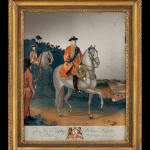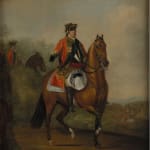A GEORGE III CHINESE-EXPORT REVERSE-PAINTED MIRROR DEPICTING THE DUKE OF CUMBERLAND
Further images
Provenance
Mallet Ltd., London
Private Collection: Rhineland, Germany
Literature
Louis Simon L’Empereur (1728-1807), Engraving, His Royal Highness William Augustus Duke of Cumberland &c. &c. &c. &c. 1751, Royal Collection (RCIN 604065) (https://www.rct.uk/collection/604065)
David Morier (1705-70), Oil on Canvas, William, Duke of Cumberland (1721-1765) c.1750, Royal Collection (RCIN 406477) (https://www.rct.uk/collection/406477)
A Chinese-export reverse-painted mirror depicting His Royal Highness William Augustus, Duke of Cumberland (1721-65), third and youngest son of George II, mounted on a bay horse, wearing a scarlet military state coat with the riband and the Star of the Garter; the landscape showing a battle with regiments in formation.
His Royal Highness Prince William Augustus, Duke of Cumberland (1721-1765) was the third and youngest son of King George II, and his wife, Caroline of Ansbach. He was Duke of Cumberland from 1726. He is best remembered for his role in putting down the Jacobite Rising at the Battle of Culloden in 1746, which made him immensely popular throughout parts of Britain. This exceptional Chinese reverse-painted mirror is directly after the 1751 engraving of the Duke by Louis Simon L’Empereur in the Royal Collection, Louis Simon himself a highly accomplished engraver based in Paris with strong links to London where he carried out many commissions. The engraving is itself after the portrait, oil on canvas, c. 1750, by David Morier of the Duke, commissioned to commemorate his victory at Culloden. Both are in the Royal Collection, RCIN 604065 and RCIN 406477 respectively.
Morier was a Swiss military and sporting painter who began working for the Duke in 1747, when he painted a series of pictures of troops under his command. From 1752 until 1764 he was employed as ‘limner’ on an annual salary of £100; his name also appears regularly in royal accounts from 1764 to 1767. During the middle of the eighteenth century, Europe produced fine quality glass that could not be matched in China. However, the expertise to execute this difficult painting technique was perfected in China, with European examples lacking their detail and sophistication. This resulted in plates of glass being shipped from Europe to China, specifically Canton, where artists would execute these stunning paintings, which were then shipped back to Europe for the burgeoning export market. The story of the creation of this particular painting is therefore a fascinating. Almost certainly unique, not depicting the typical Chinese scenes and subjects, the present example was likely executed at the special request of a patron. This glass painting is extremely fine quality and in untouched condition, retaining the original Chinese giltwood frame.





